In February 1999, I travelled around Japan with two friends of mine for one month. Below are some of the pictures I've taken during the trip with an inexpensive compact camera.
You can get a full-size version of each picture by clicking on it. I hope you enjoy them!
 This is what our typical lodging looked like (in this case, the Kikuya Ryokan in Tokyo). The traditional Japanese way of sleeping is on futon mattresses on the floor which are stowed away during the day. Japanese-style accomodation is an interesting experience but the downside of staying in old-fashioned houses in winter is that it can get very cold because the walls have little insulation and the paper windows, though beautiful, are as thin as they look. |
 The Niimi building, crowned by a chef's head, marks the entry to Kappabashi-dori, an entire street with wholesale dealers of restaurant supplies in Tokyo's Asakusa quarter. There you can get furniture, cooking utensils, plastic food models (see picture further below), crockery, signs, menus, everything. |
 One of the surprises in Japan was the large amount of visible electric wiring on the streets, even in modern cities like Tokyo. Apart from being ugly, this also seems quite dangerous to me. Maybe it's easier to fix than buried wiring in the case of an earthquake. But then, all water and gas pipes were buried and they probably break more easily than electric cables. |
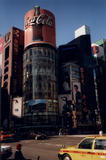 Tokyo's Ginza quarter is a trendy shopping area. The landscape picture at the bottom of the round building is actually a big color plasma screen. |
 There's a lot of interesting architecture in Tokyo. This is inside the Tokyo International Forum. |
 The Tokyo Main Station is actually quite small, unlike the big mazes at Shinjuku or Ueno. The trees are "caged" to prevent damage from heavy snow loads. |
 A tree in the outer garden of the Imperial Palace. For some reason grass in Japan turns brown in winter. |
 The Sumitomo building in Shinjuku has a triangular outline with a hollow core. Its best feature is the free observation deck from which you can overlook all of Tokyo and even see the Fuji-san in the distance when the sky is clear. |
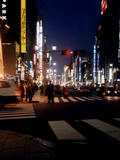 Tokyo is seven at night. :-) If you look closely you can see that Japanese traffic lights (except those for pedestrians) are horizontal. |
 The sheer amount of neon signs in some parts of Tokyo should make street lights completely unnecessary. |
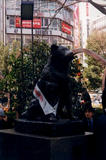 This statue in front of the Shibuya station is dedicated to the dog "Hachiko" who continued to come to the station every day for several years to await the return of his master, who had died at work. |
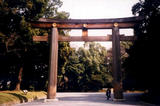 One of the huge wooden torii of the Meiji shrine in Tokyo. |
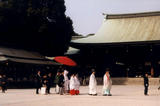 There was some kind of ceremony going on at the Meiji shrine, probably a wedding. |
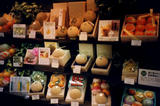 This is what the fruit section of a big department store on the Ginza looks like. Everything you see is not intended to be eaten but to give away as presents. The most beautiful and symmetrical fruits are selected for this purpose, and they are very expensive. The grapes on the right are $40, the oranges above $60, and the melons start at $100. |
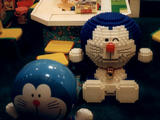 The ubiquitous Doraemon, built with Lego. A robot cat from the future, he is a very popular cartoon character in Japan, featured on lots of merchandise (like the Disney stuff here). |
 Because most streets in Japan don't have names and street numbers are not issued in a systematic way, it is nearly impossible to find someone by his/her address. Therefore maps like these that show who lives in which house are posted everywhere (this is in Kamakura). I actually never found what I was looking for on these maps. :-) Note to German readers: the "Hakenkreuz" (the mirrored version of the one used by the Nazis) is the universal symbol for Buddhist temples on maps in Japan. E.g. the big one at the lower left is the Hase-dera temple in the west of Kamakura. |
 The famous bronze Buddha statue of Kamakura, the second-largest of its kind in Japan (the only bigger one being in Nara). On the stairs in front is a group of businessmen in the typical Japanese photograph posture. For some reason, Japanese people always have to be on the pictures they take (as if nobody would believe they had really been there otherwise). In a train I once sat next to a woman who was browsing in a photo album; every picture had the same people on it, in front of changing background scenery. Very strange... |
 Such barrels containing sake are left as offerings on shrines (in this case, the Hachiman-gu shrine in Kamakura). There is also some beer at the lower left. |
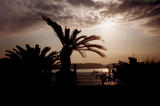 Kamakura has a beautiful beach with palm trees. This looks more like the Canary Islands than like Japan. |
 There was some construction work going on at the Nikko train station and these signs on the floor reminded you to "watch your step". I didn't know the Japanese buried landmines at train stations. :-) |
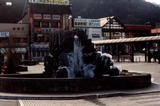 A frozen fountain in Nikko. |
 Shinto shrines are often decorated with white folded paper strips (hanging on the rope at the top). I found this big golden one at the Nikko's Toshogu shrine. |
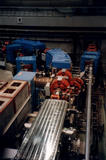 In Sendai we visited the University's electron accelerator facility. |
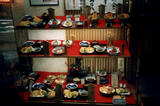 Almost every restaurant in Japan (like this tempura shop in Sendai) has plastic models of the dishes on display in front of the store which is very convenient because if you don't speak Japanese you can order by dragging the waitress outside and pointing. You can buy such models, which look very convincing, on the Kappabashi-dori in Tokyo. They make interesting souvenirs but are unfortunately not particularly cheap. |
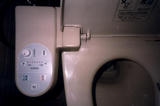 This picture was taken in the Dochuan youth hostel in Sendai (a very pleasant place). Traditional Japanese-style toilets are little more than holes in the floor but when the Japanese build Western-style bathrooms, they do it with style! This model features adjustable seat heating and automatic buttocks rinsing. Supposedly, some toilets in women's bathrooms have a button to activate electronic flushing noise because Japanese women find it embarrassing if you can hear what's "going on" on the toilet. |
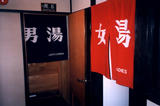 There are few things on this earth more pleasant than a Japanese bath... |
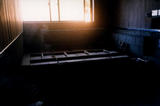 ...and the Dochuan YH had a very nice wooden one. The tub contains very hot water and is covered between uses to keep it warm. In Japan, the tub is strictly for relaxing only; you have to clean yourself outside before entering. There is a row of faucets and wooden stools in front of the tub, not visible in this picture, for this purpose. |
 This is a sweets shop in Kyoto. Probably an expensive one. |
 This is what a typical subway entry in Kyoto looks like (here, one of the entries to Imadegawa station). They are easy to miss if you don't pay attention. |
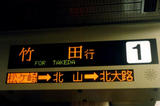 One of the nice features of the Kyoto subway system is that the displays indicate where the train currently is. In the picture, the display shows that the train for Takeda is currently at Matsugasaki whence it will continue to Kitayama and then on to Kitaoji (where this picture was taken). Despite its size Kyoto has only two subway lines, the first one opened in 1981. |
 What looks like tic-tac-toe for dummies are signs above the turnstiles of a subway station that indicate the ones you can go through. |
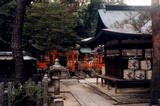 A typical shrine area in Kyoto with sake barrels, stone lanterns, red torii gates (which demark the actual sacred ground), and a grove with a path to the shrine. |
 And this is an actual shrine (one of the smaller ones). You pull the rope to ring the bell for calling the god of the shrine (whose spririt resides in or near it) before praying. At the left side is an offerings box and you can also see the white paper strips already mentioned. Most (all?) shrines have an object (such as a mirror) inside but it is usually not known what it is because it is never opened. |
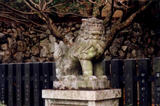 Near the entrance to a shrine there are usually a pair of guardian lion-dog statues (shishi); a female one (such as this) with her mouth closed on the left, and a male one with his mouth opened on the right. For a guardian dog, this one looks rather cute. :-) |
 The city of Kyoto is built on a plain surrounded on three sides by mountains. |
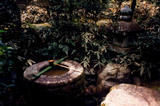 Such water basins (called tsukubai) are found in the gardens of tea houses and used by the guests to rinse their hands and mouth using the provided hishaku bamboo scoop. Like many elements of the tea ceremony, this is more of a ritualistic purification rather than an actual washing. |
 I love traditional Japanese architecture. :-) This was taken at one of the Daitoku-ji temples in Kyoto. |
 Also at Daitoku-ji, a room for tea ceremony. Note the ink paintings on the sliding doors, the tokonoma alcove with the hanging scroll and vase, and the (covered) fireplace set into the floor. |
 A large drum in front of beautiful landscape paintings at the Ryoan-ji temple. |
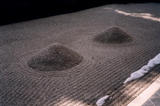 Zen stone gardens are famous throughout the world. Most of them consist of raked gravel with a couple of larger stones placed in them but this one at Daisen-in (one of the Daitoku-ji temples) is made purely of gravel. |
 Kyoto's famous Golden Pavilion, Kinkaku-ji. It is a reconstruction because the original one was burnt down in 1950 by a young monk who went nuts. |
 At the top of Kinkaku-ji is a phoenix. |
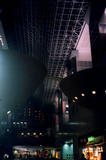 An interesting contrast to Kyoto's temples is the Main Station, an ultra-modern building with several floors of coffee shops and shopping areas (before it was destroyed in the fight between Gamera and Iris :-). |
 Japanese gardens are always pleasant, even in winter. |
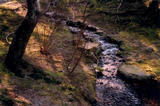 Water is an important element in landscape gardens. Apart from the obligatory pond, some also have little streams and waterfalls. This is in the garden of the Sento Imperial Palace in Kyoto. |
 The ornaments on the roofs of the palace buildings are in the shape of a chrysanthemum flower which is the crest of the emperor's family. |
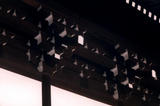 A detail of the roof construction on a different building of the palace complex. The way it is painted makes it look more intricate than it actually is. |
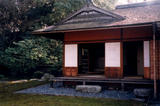 A tea house in the palace garden. |
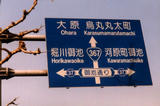 Kyoto is fairly easy to navigate because it is built in the style of a Chinese capital with a perfectly rectangular street grid aligned to the north. "Karasumamarutamachi" refers to the intersection of the streets Karasuma-dori (Kyoto's main street, running north-south, number 367) and Marutamachi-dori (running east-west). Likewise, "Kawaramachioike" is the intersection of Kawaramachi-dori and Oike-dori (number 37), and so on. Ohara is a town north of Kyoto. |
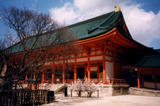 The Heian shrine in kyoto is only about 100 years old and painted with a very glaring orange color. |
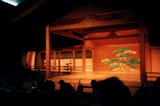 Seeing a traditional No play at the Kyoto Kanze Kaikan hall was one of the most interesting experiences of the trip, quite different from European theater. The whole performance lasted 6 hours and consisted of three different No plays, with two comic kyogen interludes. No is a very stylized form of theater, heavily influenced by Zen aesthetics. The recitative, half-chanting way of speech, the slow and dignified movements, and the repetitive music made half of the audience fall asleep. Those who managed to stay awake were busy reading the lyrics in parallel to the performance (because the language used is ancient Japanese which even natives don't understand). Also, people from the audience were constantly entering and leaving. I remember one woman with shopping bags who entered in the middle of a play, sat down next to me, slept for one hour, and then went out again. Curious... |
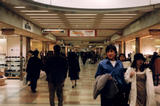 A busy shopping mall underneath the Kyoto Main Station. I selected this picture because the lack of people in most of my photographs makes it look like Japan was depopulated. :-) |
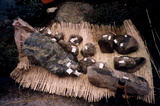 The garden of the Shugakuin Imperial Villa was undergoing repairs. Even though these gardens look very natural, nothing in them is random. The gardeners had attached little labels to the stones they took out so they could put them back again in the exact place and orientation they were before. |
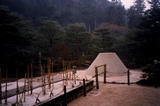 What looks like a construction site is actually the stone garden of the Ginkaku-ji temple. The cone symbolizes the Fuji-san. "Ginkaku" means "Silver Pavilion" but unlike the Kinkaku-ji shown above it is not plated with silver (this was planned but never carried out). |
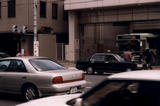 The thing to look for in this (otherwise uninteresting) picture of a bus gateway are the two gentlemen with red flags on the left and right who guide pedestrians across. Their job is completely redundant because there are traffic lights (visible on the left) in perfect working order. I have found job-creation measures such as these "flag wavers" and "sign holders" (people standing in the street holding up signs like "Restaurant XYZ, 50m this way") throughout Japan. |
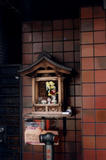 This is the smallest shrine I've seen, at a house entrance in Kyoto. |
 Kyoto at nightfall. The two bright stars are Jupiter (top) and Venus (bottom) as you can verify in an astronomy program such as xephem by setting the place to Kyoto (or Tokyo), the date and local time to 21-Feb-1999 17:30, and looking west. |
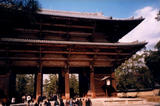 Nara has many old wooden buildings. This is the Nandai-mon gate. |
 The largest one is Daibutsu-den of the Todai-ji temple (actually the world's largest wooden building) which houses... |
 ...Japan's largest bronze Buddha statue (on the right). This one looks much more impressive than the one in Kamakura because of the gloomy atmosphere of the building, but the statue in Kamakura is more beautiful. |
 A guardian figure at the back of the room is treading down a demon. |
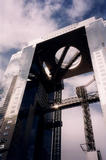 The magnificent Umeda Sky Tower in Osaka... |
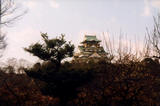 ...and the equally magnificent Osaka castle... |
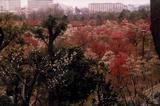 ...surrounded by beautiful apricot and plum blossoms. |
 Another good view of the castle. It is actually a concrete reconstruction and its interior is not as interesting as, for example, the castle of Himeji but the exhibition inside includes a replica of Hideyoshi Toyotomi's golden tea room which can be seen in the movie "Sen no Rikyu". |
 In the Osaka subway, as in all train and subway stations in Japan, there are barriers at both the entrance and exit to the platforms where you have to insert your ticket, so it's important to keep the ticket until the end of the trip. |
 This is what an Osaka subway ticket looks like. It is actually what's called a "free ticket", a one-day ticket valid for unlimited travel on all Osaka buses, subways and trams. Note the date on the ticket: day 19, month 2, year 11. Although Japan uses Gregorian reckoning, the old system of specifying the year using the reign name of the ruling emperor is still very predominant, and 1999 was year 11 of the heisei era (the reign name of emperor Akihito, meaning "to become flat" as the surface of the sea becomes flat after a storm). |
 One of the more colorful places in Osaka. |
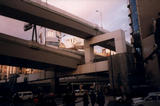 A rather risky road construction. Designs like this will probably be the first to come down in the case of a major earthquake. |
 This is one of the restaurants in Osaka's Dotombori street. |
 The White Egret Castle of Himeji has been featured in many samurai movies. It is one of the few that are not a reconstruction but original, and also one of the most impressive ones. |
 In the Peace Memorial Park of Hiroshima you can find millions of paper cranes, folded by people from all over the world. The full story of the girl Sadako and her paper cranes can be found here. |
 The castle of Hiroshima is (of course) also a reconstruction but it looks more snugly than the castle of Osaka. Inside is a very interesting exhibition about the construction of the castle. The soft ground on which it is built had to be stabilized with lots of long boles to prevent the castle from tilting. |
 This is the famous "floating" torii of the Itsukushima shrine on Miyajima island, the one that's on the cover of many guidebooks. At the time the picture was taken it was low tide however, so the torii is not floating but sticking in the mud. :-) |
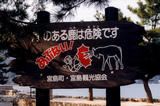 "The deer with antlers are dangerous. Watch out!" |
 This is what those fierce creatures actually looked like. :-) |
 A statue of a horse at the Istukushima shrine. |
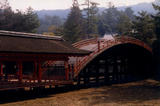 I know the Japanese love round bridges, but this seems a little excessive... |
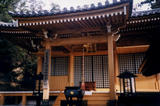 Miyajima is a holy island; this is the main hall of the Dainichi-do temple near the top of Mount Misen, the highest peak of Miyajima. |
 This pot was once used by the founder of the temple and has supposedly been kept simmering for 1200 years. |
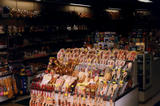 The number one souvenir to get from Miyajima are wooden rice scoops. |
 The town of Beppu is famous for its hot springs. This is one found on the street. |
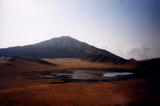 The Aso-san in central Kyushu is an active volcanic area inside a gigantic crater of 24km diameter, with plenty of interesting walks. Here you can see the Kusasenri meadow. |
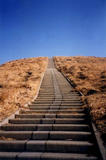 The stairway to heaven, or at least to the top of Kijimadake, one of the smaller peaks of the Aso-san. |
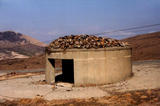 Since some of the Aso volcanoes are still active, there are "bomb shelters" like this everywhere. I've been told that this is also exactly what bus stops in Greece look like. :-) |
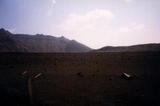 The Sunasenri ash plain seems to go on and on forever. |
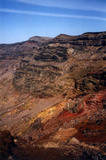 Volcanic rock often has nice colors. |
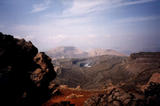 This is the central crater of Aso-san. It was a quiet day, only some smoke coming out. |
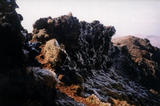 The white stuff on this picture are ice crystals. |
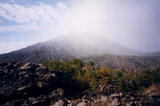 The Sakurajima in the south of Kyushu is also an active volcano. There was smoke constantly coming out at the top. In the foreground you can see new forest growing on the solidified lava (the last big eruption has been in 1960). |
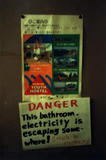 Despite being a volcano, there are several villages and a youth hostel on Sakurajima but this sign at the YH made me feel more insecure. :-) |
 This torii was buried during an eruption in 1914. This eruption also connected Sakurajima to the mainland of Kyushu, converting it from an island to a peninsula. |
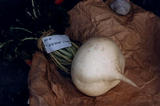 Volcanic ash seems to be fertile, judging by the size of the radish. |
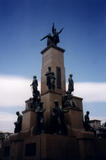 A statue in Kagoshima (near Sakurajima) dedicated to 17 young people who left Japan to study European technology in 1865 when it was forbidden upon penalty of death for Japanese to leave the country. |
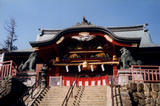 The Mitake-san near Tokyo is a holy mountain with a colorful shrine on top. Here you can also see the guardian dogs on the left and right. |
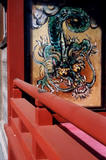 It looks almost as if this dragon had put its claw on the railing... |
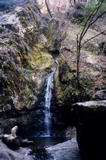 The Mitake area is pleasant for hiking. This is the beautiful Nanayo waterfall. |
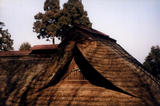 Traditionally, Japanese country houses have reed-thatched roofs. |
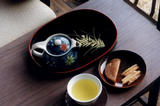 It's tea time. :-) |
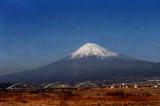 No Japan photo gallery would be complete without a picture of the Fuji-san. This one was taken from inside the train on the way from Kyoto to Tokyo. |
Want more? Them have a look at the pictures of my second trip!
